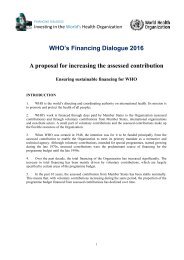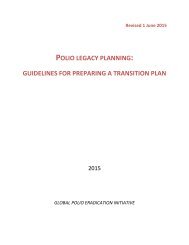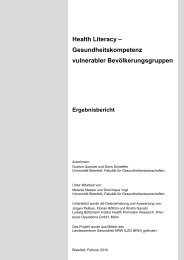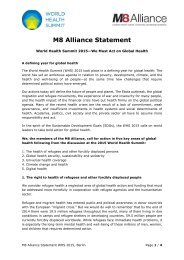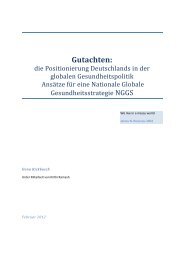Tackling-health-inequities-from-concepts-to-practice-The-experience-of-Vastra-Gotaland
Tackling-health-inequities-from-concepts-to-practice-The-experience-of-Vastra-Gotaland
Tackling-health-inequities-from-concepts-to-practice-The-experience-of-Vastra-Gotaland
- No tags were found...
You also want an ePaper? Increase the reach of your titles
YUMPU automatically turns print PDFs into web optimized ePapers that Google loves.
on Social Determinants <strong>of</strong> Health, these conditions are, in turn, shaped bypolitical, social and economic forces (3). As a consequence, tackling <strong>health</strong>inequalities requires joint action by multiple ac<strong>to</strong>rs and stakeholders. It isnecessary <strong>to</strong> look at the process <strong>of</strong> policy-making, how decisions are madethat might influence the distribution <strong>of</strong> the social determinants <strong>of</strong> <strong>health</strong> andthe response in terms <strong>of</strong> implementation and effects on the distribution <strong>of</strong><strong>health</strong> in the population.Following the launch <strong>of</strong> the final report <strong>from</strong> the WHO Commission onSocial Determinants <strong>of</strong> Health in late 2008 (3), the Regional Councilin Region Västra Götaland decided <strong>to</strong> start a joint venture <strong>to</strong> tackleinequalities in <strong>health</strong> in its Region. <strong>The</strong> challenge was <strong>to</strong> identifyactions that should be efficient and concrete, and also <strong>to</strong> attract differentstakeholders with different agendas and objectives <strong>to</strong> make a joint effort<strong>to</strong> tackle <strong>health</strong> inequalities within the region and, at the same time, havepolitical commitment <strong>to</strong> the work.This report aims <strong>to</strong> summarize the process, which evolved as a result <strong>from</strong>the Regional Council’s decision. Section 2 presents a short background onhow the process began, and Section 3 gives an account <strong>of</strong> the theoreticalframework that served as a compass for the process. Section 4 describes theprocess and the Action Plan for Health Equity in Region Västra Götaland (4)and provides an analysis on success fac<strong>to</strong>rs as well as pitfalls. <strong>The</strong> last sectionis a discussion in which certain important parts <strong>of</strong> the process are highlighted.This report adds <strong>to</strong> the growing number <strong>of</strong> reports on joint efforts <strong>to</strong> tackle<strong>health</strong> inequalities, such as the Norwegian case (5) and Malmö’s path <strong>to</strong>wardsa sustainable future (6) in Sweden. <strong>The</strong>se reports might inspire others <strong>to</strong>launch similar local and regional processes. An underlying theme in thesereports is governance – the idea that interdependence among societal ac<strong>to</strong>rsrequires joint action <strong>to</strong> make a difference – a core message in the WHOHealth 2020 strategy (7). This report illustrates a regional effort <strong>to</strong> establish anetwork <strong>of</strong> stakeholders, based on previous reviews on <strong>health</strong> <strong>inequities</strong>.Even if there can be no universal solution that works in all contexts, a strategy<strong>to</strong> reduce <strong>health</strong> inequalities must recognize the complexity in modernsocieties, which are increasingly interdependent in a globalized worldand thus require new approaches <strong>to</strong> governance where key goals includeSection 1. Introduction3




